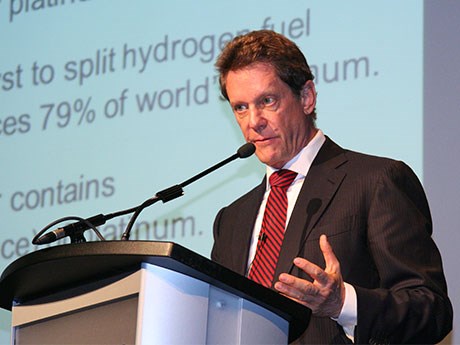Mining luminary talks up copper, platinum and zinc
“The supercycle for metals is very much alive,” according to internationally renowned financier and mining luminary Robert Friedland.
Kicking off a lecture series at Laurentian University’s Goodman School of Mines in Sudbury October 9th, the executive chairman of Ivanhoe Mines said, “Anyone who tells you that the supercycle is over is completely idiotic.
“The fundamental, overwhelming, most important phenomenon of our age is urbanization,” he said. “In 1970, when I was 20 years old, 39 million people lived in magacities – that’s cities with a population of more than 10 million. There were only two of them – New York and Tokyo. By 2011, we had 359 million people in 23 megacities and, tomorrow morning in geological time, 2025, we’ll have 630 million people living in megacities.”
From 1900 to the present, said Friedland, world consumption of copper totalled 585 million tonnes. With hydrogen fuel cell automobiles, high-speed trains, the Internet and the a rapidly growing global middle class snapping up air conditioners and stainless steel woks, we’ll need 600 million tonnes of copper over the next 20 years, “and we don’t know where it’s going to come from,” he warned. Lamenting popular ignorance about the supply chain, Friedland complained that people “have no idea where things come from.
“Americans think a ham sandwich comes out of a refrigerator. No one thinks about what it’s like to slaughter 50 million pigs a year to deliver that ham sandwich.”
Voisey’s Bay
Friedland’s two major claims to fame are the discovery of the nickel-rich Voisey’s Bay deposit by Diamond Fields Resources, which he sold to Inco for $4.3 billion in 1996, and Oyu Tolgoi in Mongolia, one of the world’s largest copper-gold porphyry deposits.
Shares of his company, Diamond Fields Resources, skyrocketed from $1 to $161, and when the price hit $40, a columnist in Canada’s Globe and Mail newspaper wrote “a nasty article” telling investors they “might as well go to Nevada and roll the dice,” Friedland recalled. “However, anyone buying Diamond Fields shares when the article was published quadrupled their money in five months.
“Everybody said Inco paid too much for Voisey’s Bay, but in 1996 China hadn’t been invented yet and we didn’t know that Mrs. Wong would want a stainless steel wok, so by the time Voisey’s Bay came on stream, it was worth every nickel.”
Oyu Tolgoi, which was gradually acquired by Rio Tinto and began shipping copper this past summer, contains an estimated resource of 2.7 million tonnes of copper and 1.7 million ounces of gold. Its number two shaft is 10 metres in diameter and has a hoisting capacity of 50,000 tonnes a day, he said. Ultimately, production from Oyu Tolgoi will increase to 300,000 tonnes per day from a total of seven shafts, he predicted.
Far from resting on his laurels, Friedland has a trio of new projects in Africa focusing on platinum, copper and zinc.
The Platreef platinum-nickel-copper deposit in the South African province of Limpopo boasts a NI 43- 01 compliant indicated resource of 214 million tonnes grading 4.1 g/t platinum, palladium, gold and rhodium. The orebody is perfectly flat with a thickness of 24 metres and open in every direction.
“If you go to a typical platinum mine today, you crawl for a kilometre or two on your hands and knees to get to the working face. The rock is 50 degrees Celsius and the humidity is close to 100 per cent. You can’t stand up and there’s virtually no ventilation.
“How can Toyota Motor Corporation build a new generation of fuel cell vehicles to clean up the air in China and the U.S. when platinum is mined like that?” he asked.
“This discovery is much bigger than Bre-X, but it has the distinct advantage of being real and it’s remarkable how many people are not noticing it.”
Friedland attributed the lack of interest to a bias against Africa and the public perception of a continent full of “bushmen, blowguns and lions.”
Indeed, geopolitical risk is one of the reasons cited, along with the downturn in the mining sector as a whole, for a close to 50 per cent plunge in Ivanhoe’s share price this year.
Actually, “Limpopo is a very civilized place, a very beautiful part of the world with friendly, intelligent people,” Friedland said.
Congo
Ivanhoe Metals also has two projects in the Democratic Republic of the Congo. The Kamoa copper deposit 25 kilometres west of Kolwezi boasts a mineral resource estimate of 739 million tonnes grading 2.9 per cent copper, while the Kipushi Big Zinc project boasts grades averaging 11 per cent zinc and seven per cent copper. Kamoa, said Friedland “is a transformative orebody,” but “we need 20 more of them.”
The Goodman School of Mines can play a role in preparing Africa for the next wave of mineral development, said Friedland. “They’re not going to be down there with a jackleg making $12 a day,” he said. “They’re going to be driving air-conditioned equipment like in Sudbury and will be paid like dental surgeons.”


